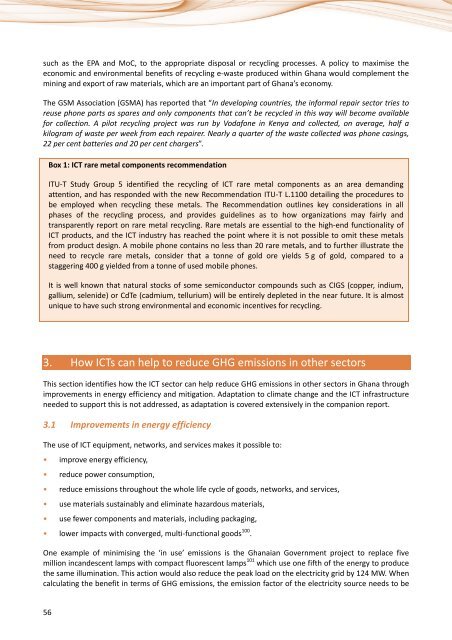Information and communication technologies (ICTs) and ... - ITU
Information and communication technologies (ICTs) and ... - ITU
Information and communication technologies (ICTs) and ... - ITU
Create successful ePaper yourself
Turn your PDF publications into a flip-book with our unique Google optimized e-Paper software.
such as the EPA <strong>and</strong> MoC, to the appropriate disposal or recycling processes. A policy to maximise the<br />
economic <strong>and</strong> environmental benefits of recycling e-waste produced within Ghana would complement the<br />
mining <strong>and</strong> export of raw materials, which are an important part of Ghana’s economy.<br />
The GSM Association (GSMA) has reported that “In developing countries, the informal repair sector tries to<br />
reuse phone parts as spares <strong>and</strong> only components that can’t be recycled in this way will become available<br />
for collection. A pilot recycling project was run by Vodafone in Kenya <strong>and</strong> collected, on average, half a<br />
kilogram of waste per week from each repairer. Nearly a quarter of the waste collected was phone casings,<br />
22 per cent batteries <strong>and</strong> 20 per cent chargers”.<br />
Box 1: ICT rare metal components recommendation<br />
<strong>ITU</strong>-T Study Group 5 identified the recycling of ICT rare metal components as an area dem<strong>and</strong>ing<br />
attention, <strong>and</strong> has responded with the new Recommendation <strong>ITU</strong>-T L.1100 detailing the procedures to<br />
be employed when recycling these metals. The Recommendation outlines key considerations in all<br />
phases of the recycling process, <strong>and</strong> provides guidelines as to how organizations may fairly <strong>and</strong><br />
transparently report on rare metal recycling. Rare metals are essential to the high-end functionality of<br />
ICT products, <strong>and</strong> the ICT industry has reached the point where it is not possible to omit these metals<br />
from product design. A mobile phone contains no less than 20 rare metals, <strong>and</strong> to further illustrate the<br />
need to recycle rare metals, consider that a tonne of gold ore yields 5 g of gold, compared to a<br />
staggering 400 g yielded from a tonne of used mobile phones.<br />
It is well known that natural stocks of some semiconductor compounds such as CIGS (copper, indium,<br />
gallium, selenide) or CdTe (cadmium, tellurium) will be entirely depleted in the near future. It is almost<br />
unique to have such strong environmental <strong>and</strong> economic incentives for recycling.<br />
3. How <strong>ICTs</strong> can help to reduce GHG emissions in other sectors<br />
This section identifies how the ICT sector can help reduce GHG emissions in other sectors in Ghana through<br />
improvements in energy efficiency <strong>and</strong> mitigation. Adaptation to climate change <strong>and</strong> the ICT infrastructure<br />
needed to support this is not addressed, as adaptation is covered extensively in the companion report.<br />
3.1 Improvements in energy efficiency<br />
The use of ICT equipment, networks, <strong>and</strong> services makes it possible to:<br />
• improve energy efficiency,<br />
• reduce power consumption,<br />
• reduce emissions throughout the whole life cycle of goods, networks, <strong>and</strong> services,<br />
• use materials sustainably <strong>and</strong> eliminate hazardous materials,<br />
• use fewer components <strong>and</strong> materials, including packaging,<br />
• lower impacts with converged, multi-functional goods 100 .<br />
One example of minimising the ‘in use’ emissions is the Ghanaian Government project to replace five<br />
million inc<strong>and</strong>escent lamps with compact fluorescent lamps 101 which use one fifth of the energy to produce<br />
the same illumination. This action would also reduce the peak load on the electricity grid by 124 MW. When<br />
calculating the benefit in terms of GHG emissions, the emission factor of the electricity source needs to be<br />
56

















